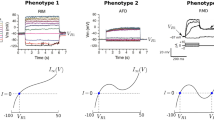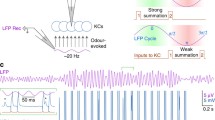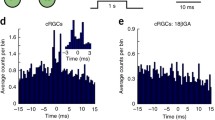Abstract
The role of relative spike timing on sensory coding and stochastic dynamics of small pulse-coupled oscillator networks is investigated physiologically and mathematically, based on the small biological eye network of the marine invertebrate Hermissenda. Without network interactions, the five inhibitory photoreceptors of the eye network exhibit quasi-regular rhythmic spiking; in contrast, within the active network, they display more irregular spiking but collective network rhythmicity. We investigate the source of this emergent network behavior first analyzing the role of relative input to spike–timing relationships in individual cells. We use a stochastic phase oscillator equation to model photoreceptor spike sequences in response to sequences of inhibitory current pulses. Although spike sequences can be complex and irregular in response to inputs, we show that spike timing is better predicted if relative timing of spikes to inputs is accounted for in the model. Further, we establish that greater noise levels in the model serve to destroy network phase-locked states that induce non-monotonic stimulus rate-coding, as predicted in Butson and Clark (J Neurophysiol 99:146–154, 2008a; J Neurophysiol 99:155–165, 2008b). Hence, rate-coding can function better in noisy spiking cells relative to non-noisy cells. We then study how relative input to spike–timing dynamics of single oscillators contribute to network-level dynamics. Relative timing interactions in the network sharpen the stimulus window that can trigger a spike, affecting stimulus encoding. Also, we derive analytical inter-spike interval distributions of cells in the model network, revealing that irregular Poisson-like spike emission and collective network rhythmicity are emergent properties of network dynamics, consistent with experimental observations. Our theoretical results generate experimental predictions about the nature of spike patterns in the Hermissenda eye.
Similar content being viewed by others
References
Abbott LF, van Vreeswijk CA (1993) Asynchronous states in networks of pulse-coupled oscillators. Phys Rev E 48: 1483
Alkon DL, Fuortes MGF (1972) Responses of photoreceptors in Hermissenda. J Gen Phisiol 60: 631–649
Amit DJ, Brunel N (1997) Model of global spontaneous activity and local structured activity during delay periods in the cerebral cortex. Cerebral Cortex 7(3): 237–252
Berman N, Maler L (1998) Inhibition evoked from primary afferents in the electrosensory lateral line lobe of the weakly electric fish (Apteronotus leptorhynchus). J Neurophysiol 80: 3173–3196
Blackwell KT (2006) Ionic currents underlying difference in light responses between type A and type B photoreceptors. J Neurophysiol 95: 3060–3072
Bressloff P, Coombes S (2000) Dynamics of strongly coupled spiking neurons. Neural Comput 12: 91–129
Brown E, Moehlis J, Holmes P (2004) On the phase reduction and response dynamics of neural oscillator populations. Neural Comput 16: 673–715
Brunel N, Hakim V (1999) Fast global oscillations in networks of integrate-and-fire neurons with low firing rates. Neural Comput 11: 1621–1671
Brunel N, Hansel D (2006) How noise affects the synchronization properties of recurrent networks of inhibitory neurons. Neural Comput 18: 1066–1110
Bryant HL, Segundo JP (1976) Spike initiation by transmembrane current: a white noise analysis. J Physiol 260: 279–314
Butson CR, Clark GA (2008a) Random noise paradoxically improves light-intensity encoding in Hermissenda photoreceptor network. J Neurophysiol 99: 146–154
Butson CR, Clark GA (2008b) Mechanisms of noise-induced improvement in light-intensity encoding in Hermissenda photoreceptor network. J Neurophysiol 99: 155–165
Chacron MJ, Longtin A, St-Hilaire M, Maler L (2000) Suprathreshold stochastic firing dynamics with memory in P-type electroreceptors. Phys Rev Lett 85: 1576–1579
Eakin RM, Westfall JA, Dennis MJ (1967) Fine structure of the eye of a nudibranch mollusc Hermissenda Crassicornis. J Cell Sci 2: 349–358
Ermentrout GB, Galán RF, Urban NN (2007) Relating neural dynamics to neural coding. Phys Rev Lett 99: 248103
Ermentrout GB, Kopell N (1990) Oscillator death in systems of coupled neural oscillators. SIAM J Appl Math 50: 125
Ermentrout GB, Saunders D (2006) Phase resetting and coupling of noisy neural oscillators. J Comput Neurosci 20: 179–190
Fusi S, Mattia M (1999) Collective behavior of networks with linear (VLSI) integrate-and-fire neurons. Neural Comput 11: 633–652
Gardner CW (1994) Handbook of stochastic methods. Springer, Berlin
Gerstner W (2000) Population dynamics of spiking neurons: fast transients, asynchronous states, and locking. Neural Comput 12: 43–89
Glass L, Mackey MC (1988) From clocks to chaos: the rhythms of life. Princeton University Press, Princeton, NJ
Jazayeri M, Movshon A (2006) Optimal representation of sensory information by neural populations. Nat Neurosci 9: 690–696
Kohn AF, Freitasda Rocha A, Segundo JP (1981) Presynaptic irregularity and pacemaker inhibition. Biol Cybern 41: 5–18
Kuramoto Y (1984) Chemical oscillations, waves, and turbulence. Dover Books, New York, NY
Mainen ZF, Sejnowski TJ (1995) Reliability of spike timing in neocortical neurons. Science 268: 1503–1506
Ma JM, Beck JM, Latham PE, Pouget A (2006) Bayesian inference with probabilistic population codes. Nat Neurosci 9: 1432–1438
Mar DJ, Chow CC, Gerstner W, Adams RW, Collins JJ (1999) Noise shaping in populations of coupled model neurons. Proc Natl Acad Sci USA 96: 10450–10455
Maran SK, Canavier C (2008) Using phase resetting to predict 1:1 and 2:2 locking in two neuron networks in which firing order is not always preserved. J Comput Neurosci 24: 37–55
Mo JL, Blackwell KT (2003) Comparisson of Hermissenda type A and type B photoreceptors: response to light as a function of intensity and duration. J Neurosci 23(22): 8020–8028
Nesse WH, Borisyuk A, Bressloff PC (2008) Fluctuation-driven rhythmogenesis in an excitatory neuronal network with slow adaptation. J Comput Neurosci 25: 317–333
Nesse WH, Clark GA, Bressloff PC (2007) Spike patterning of a stochastic phase model neuron given periodic inhibition. Phys Rev E 75: 031912
Oh M, Matveev V (2009) Loss of phase-locking in non-weakly coupled inhibitory networks of type-I model neurons. J Comput Neurosci 26(2): 303–320
Perkel DH, Schulman JH, Bullock TH, Moore GP, Segundo JP (1964) Pacemaker neurons: effects of regularly spaced synaptic input. Science 145: 61–63
Roddey JC, Girish B, Miller JP (2000) assessing the performance of neural encoding models in the presence of noise. J Comput Neurosci 8: 95–112
Rubin J, Josić K (2007) The firing of an excitable neuron in the presence of stochastic trains of strong synaptic inputs. Neural Comput 19: 1251–1294
Schultz LM, Clark GA (1997) GABA-induced synaptic facilitation at type B to A photoreceptor connections in Hermissenda. Brain Res Bull 42: 377–383
Steinmetz PN, Manwani A, Koch C, London M, Segev I (2000) Subthreshold voltage noise due to channel fluctuations in active neuronal membranes. J Comput Neurosci 9: 133–148
Stevens CF, Zador AM (1998) Input synchrony and the irregular firing of cortical neurons. Nat Neurosci 3: 210–217
Wehr M, Zador AM (2003) Balanced inhibition underlies tuning and sharpens spike timing in auditory cortex. Nature 436: 442–446
White JA, Klink R, Alonso A, Kay AR (1998) Noise from voltage-gated ion channels may influence neuronal dynamics in the entorhinal cortex. J Neurophysiol 80: 262–269
Yamanobe T, Pakdaman K (2002) Response of a pacemaker neuron model to stochastic pulse trains. Biol Cybern 86: 155–165
Author information
Authors and Affiliations
Corresponding author
Rights and permissions
About this article
Cite this article
Nesse, W.H., Clark, G.A. Relative spike timing in stochastic oscillator networks of the Hermissenda eye. Biol Cybern 102, 389–412 (2010). https://doi.org/10.1007/s00422-010-0374-x
Received:
Accepted:
Published:
Issue Date:
DOI: https://doi.org/10.1007/s00422-010-0374-x




